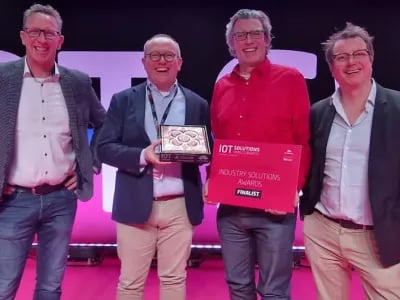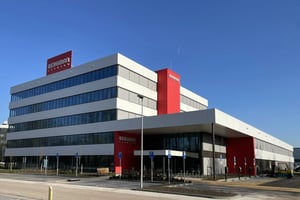NS and IT partner AMIS Conclusion have won the Industry Solutions Award 2023 for the best 'smart buildings and smart cities' solution, with their 3D digital twin of Utrecht Central Station. The NS team received the award in Barcelona during the IoT Solutions World Congress: the largest IoT event in the world with 16,000 visitors.
The award represents international recognition for the innovative vision of NS Stations and their IT partner AMIS Conclusion. AMIS Conclusion played an essential role in activating the real-time data feed of this digital twin model. A digital twin is a digital copy of reality – including all relationships – that adjusts in real time, keeping pace with changes in the physical world. NS uses the digital twin to process real-time information from digital assets (such as lifts, escalators, pressure meters and smart energy meters) at the station and project this into a digital 3D model of the station in real time. This provides the station managers with a real-time overview of the status of the station and allows them to intervene when necessary. The model is also able to establish relationships between data-producing objects in the building, enabling extensive analyses and predictions to be made to improve safety, prevent defects, and enhance passenger comfort.
What is a digital twin and what can you do with it?
Jean Keultjes, Digital lead of NS Stations IT, said: “The digital twin was created by collecting and processing 20 billion fine-meshed lidar data points and 540 high-resolution drone images into a 3D model, and by visualizing information in that model. This model is fed with real-time telemetry data from lifts, escalators and a wide range of Lora sensors. Of course everything meets the highest requirements to ensure the security and privacy of this data. We used the expertise of AMIS Conclusion to unlock the telemetry data. They realised the logic and the platform for us to retrieve the real-time data as well as process it in the model.”
Jean continued: “The model enables us to easily map the current structure of the building down to the detail, including real-time use of objects within the building, like lifts and escalators. We can do this now without having to consult an enormous number of individual sensors through isolated dashboards. That's incredibly valuable to us.” Robbrecht van Amerongen, Head of IoT at AMIS Conclusion, added: “The model can be used to identify equipment defects, but also to simulate the impact of failures through various scenarios. That can help to make better decisions to optimise passenger routing, safety, maintenance, and sustainability.”
What are the benefits of a digital twin and what are the possibilities for the future?
Jean: “The digital twin model dramatically increases the information that station managers have about what goes on in a station throughout any given day. It also enables us to plan maintenance of lifts and escalators with minimal impact on passenger flows. Moving into the future, we will be able to track energy waste and peak loads, helping us to reduce our carbon footprint. And audio analysis can help us automatically detect undesirable behavior and intervene more rapidly in panic situations.”
How does the implementation affect ecological, social, or economic sustainability?
Robbrecht: “The digital twin contributes to the overall experience of the people who use the station. Thanks to real-time insights and historical data, we can plan maintenance more effectively and reduce the energy use of equipment.” Jean adds: “And by projecting this data into an accurate and recent 3D model, the meaning of the data in relation to the structure of the building is made much clearer, less subject to interpretation. In short, the model contributes to sustainability, cost efficiency, and a better customer experience.”
What noteworthy results have you already achieved with the digital twin of the station?
Jean: “At its core, the digital twin enables you to understand the current conditions in a station from a distance. First of all, the model provides an integrated view of the entire building. That means our employees no longer have to combine data from multiple systems to construct an understanding of the current situation. The model also helps us take very effective measures to limit climate change and realise our commitment to the goals of the Paris 2030 treaty. On the customer side, the digital twin model improves the experience of the station due to increased availability of essential services like escalators and lifts – since maintenance is now aligned with use. In the coming years, we will be developing additional use cases to combine the structural features of the building, the use of real-time sensors and data on passenger flows to reduce costs and improve customer experience. Fundamentally, the possibilities are endless!”













